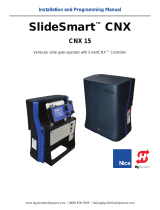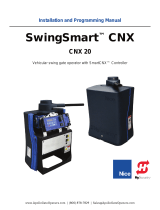
• A minimum of two (2) WARNING SIGNS shall be installed, one on each
side of the gate where easily visible.
• Test all features for proper functions before placing the automatic vehicular
gate operator into service.
• Demonstrate the basic functions and safety features of the gate system to
owners/end users/general contractors, including how to turn off power
and how to operate the manual release feature.
•
Leave safety instructions, product literature, installation manual and
maintenance instructions with end user.
• Explain to the owners/users the importance of a service contract that
includes a routine testing of the entire system including the entrapment
protection devices, and explain the need for the owners to insure that this
testing is performed routinely.
• Offer the owner/end user a maintenance contract, or contact them
regularly to offer maintenance.
• See instructions on the placement of non contact sensors for each type of
application.
Always
follow
all instructions included in this manual to ensure safety and
the longevity of the operator.
THIS CIRCUIT BOARD IS INTENDED FOR USE WITH VEHICULAR
SWING AND SLIDE GATES ONLY.
an automatic gate system is installed. Use only solenoid-locks
controlled by the system.
• Turn the power to the gate controller OFF AND REMOVE
•
•
•
BATTERIES before using the emergency release.
deniatniam ylreporp setag peeK - 9.3
Have only a qualified service person make repairs. Unqualified service
technicians are not recommended.
4 - INSTALLATION NOTES
ro/dna srellatsni ,renepo etag eht gnitarepo ro/dna gnillatsni erofeB
users should do the following:
Confirm the gate operator being installed is appropriate for the site.
Confirm the gate is designed and built according to current applicable
published industry standards.
Confirm all appropriate features and accessory devices are being
incorporated, including both inherent and external entrapment
protection devices.
Automatic gate operators are designed to move a heavy steel gate. Great
amounts of force are sometimes used to move these heavy systems. The
automatic gate system may cause significant damage or injury if the path of
the gate is obstructed. All sensors, safety devices and warning notices must
be in place and operable in order for this system to operate properly. It is
the i nstaller’s responsibility to install this system properly and to ensure its
correct and safe operation.
I nfrared beams are used to inform the control board that an obstruction is
present. Safety devices must be installed properly and inspected periodically
to ensure continued reliability and safety. Safety devices, safety sensors,
warning signs and notices of moving equipment danger must be installed
and readily visible by all paths of approach to the gate system. Failure to
. post warnings could result in loss of life, damage or physical injury.
The installer of this system needs to establish the location of the opener in
si tuoyal lacipyt A .launam siht nihtiw deniatnoc snoitcurtsni htiw ecnadrocca
eht si tI .gniward cisab lanimon a htiw launam siht fo dne eht ta dedivorp
installer’s responsibility to ensure that the opener is installed in such a
eht fo noitalucitra reporpmi ro gnihcnip ,gnidnib tneverp ot sa os noihsaf
system throughout its actuation cycle.
3.7 - Keep children away
Never let children operate or play with gate controls. Keep the remote
control away from children.
3.8 - Test the gate system
The gate must reverse on contact with a rigid object and stop when an
object activates the non-contact sensors. After adjusting the force or the limit
of travel, retest the gate operator. Failure to adjust and retest the gate
operator properly can increase the risk of injury or death. Test force and
correct f unctionality of photo-eyes and other safety devices at least every 6
months. ONLY USE the MANUAL RELEASE when the gate is not moving or
when the unit fails or in case of power outage.
• Make sure the gate moves freely before installing the operator.
• Repair or service worn or damaged gate hardware before installing the
operator.
• Adjust the FORCE device to the minimum force setting that allow
s
reliable gate operation.
• Install operator inside fence line (DO NOT install operator on public side
of fence line).
• Swinging gates shall not open into public access areas.
• Install a proper electrical ground to a gate operator and attach the
ground rod to the earth ground connector on the 936 board (see section
5) .
• Install keypad controls where users cannot touch, or reach through gate
while operating controls, which is a minimum of 8 feet from the gate.
• Install controls where user has full view of gate operation.
• Install all warning signs (In accordance with UL 325) on both sides of the
gate to warn persons in the area of potential hazards associated with the
automatic vehicular gate operation.
i
4.3.1
4.3.
4.3.
4.3.
Gate terms “system, “gate operator”, “gate system”, and “gate
operator system” for these warnings, cautions, and notes is
intended to cover the gate controller, gate controller software,
the gate actuator, and all safety accessories included within a typical
installation.
Gate system designers, installers and users must take into
consideration the inherent hazards associated with each installation,
since no two installations will be exactly alike .
Improperly designed, constructed, installed or maintained systems
can and may introduce hazards which may or may not be readily
seen or identified by users, bystanders, installers or inspectors.
All pinch points must be guarded or eliminated.
Only install this gate system opener in appropriate manners in
which the operation is safe and secure.
A gate operator exerts a great amount of force in order to move
the gate system in normal operation, therefore appropriate safety
sensors, measures, notices and appropriate safety features mus t be
incorporated in all installations.
The gate must be installed correctly and no binding or resistance
should be present throughout its movement in either direction.
The gate system must be installed in an area and in such a manner
in which the gate has sufficient clearance to open, close and move
without striking or contacting any structures and/or other
obstructions.
The gate system is designed for vehicular traffic only, and should
never, under any situation be used for pedestrian traffic.
Pedestrian prohibited signs, warning signs or other suitable
measures must be used at minimum, to warn pedestrians to
stay away from, and to not use this system under any
circumstances.
Pedestrians should be encouraged to use a pedestrian entry/exit
only.
Pedestrians should never cross the path of a moving gate. The
sensors are designed to prevent contact with a vehicle and are not
necessarily capable of preventing contact with a pedestrian. Care
should be take to prevent pedestrian usage under any
circumstances.
One or more non-contact sensors must be used in any
situation or area where entrapment may have the possibility of
occurring.
Gates shall be constructed in accordance with the provisions given
for the appropriate gate type listed, refer to ASTM F2200
for additional gate types.
Any existing manual gate latches shall be removed or disabled when
4.3.5
4.3.6
4.3.7
4.3.8
4.3.9
4.3.10
4.3.11
4.3.12
4.3.13
4.3.14
4.3.15
www.ApolloGateOpeners.com | (800) 878-7829 | Sales@ApolloGateOpeners.com






















